The STARs Shine Brightly in Las Vegas
It’s all there at the NAB Show—4K video, Mobile DTV, 3DTV, multiplatform production, the cloud—you name it! And to make sure that the brightest stars in the pack are recognized for their accomplishments, TV Technology selects from the best of the best and bestows our STAR Award. Congratulations to this year’s winners of TV Technology’s STAR Award—now in its 12th year of recognizing technical excellence!
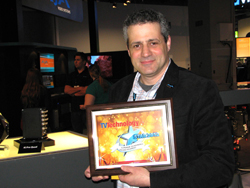
Nick Rashby, AJA’s president, accepts the STAR for the Ki Pro Quad, a high quality compact, solid-state portable video recorder with Thunderbolt connectivity. Ki Pro Quad captures high-quality edit-ready files in HD (1920x1080), 2K (2048x1080), Quad HD (3840x2160), and 4K (4096x2160).
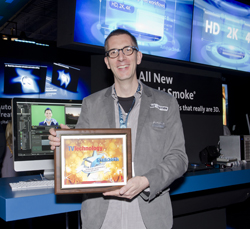
Marc Hamaker from Autodesk accepts the STAR for Smoke for Max 2013. A new user interface for their Smoke 2013 NLE on the Mac now offers node-based compositing on the timeline; increased support for compressed video formats; Thunderbolt I/O; and lower system requirements thanks to GPU-accelerated effects.
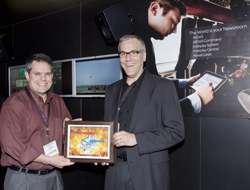
Avid’s Dana Ruzicka (L) and Alan Hoff accept the STAR for the company’s Interplay Sphere. The cloud-based platform enables distributed, collaborative acquisition, browsing and production over the Internet.
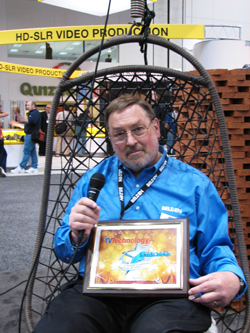
Belden’s Stephen Lampen accepts the STAR while seated in a swing, supported by Belden’s new high-strength 1776 mic cable. Belden’s new cable is constructed with high-strength conductors and a very tough rubber jacket, allowing it to withstand much more abuse than conventional cables.

Blackmagic Design’s Grant Petty accepts the STAR for the Cinema Camera. The camera has a 2.5K sensor and features a built-in solid state disk recorder, 13 stops of dynamic range, and DaVinci color correction. It mounts EF-mount lenses and has a touchscreen for entering metadata—all for less than $3,000.
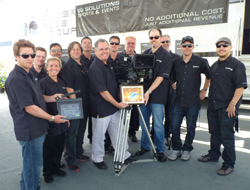
The Cameron|Pace Group with co-founder Vince Pace (C), accepts the STAR for the company’s Shadow 5D Production Suite. This integrated 3D/2D production system enables one cameraman to shoot 2D and 3D simultaneously and seamlessly.
The professional video industry's #1 source for news, trends and product and tech information. Sign up below.
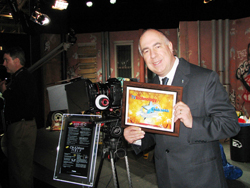
Chuck Westfall, Canon technical advisor for education and training, accepts the STAR for Canon’s EOS-1D C 4K DSLR camera. Equipped with an 18.1-megapixel full-frame 24mm x 36mm Canon CMOS sensor, it records 8-bit 4:2:2 Motion JPEG 4K video to the camera’s CF card at 24 fps or Full HD 1920x1080 video at selectable frame rates from 24p to 60p.
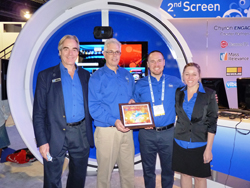
Chyron’s Michael Wesley-Wellesley, Jim Martinotich, Joe Foxton and Nikole McPhee accept the STAR for the company’s Engage technology, which lets a broadcaster go to air with Twitter comments, but still has an easy way to screen Twitter postings for appropriateness. Engage looks good doing it, too.

Cobalt Digital’s Bob McAlpine (L) and Chris Shaw accept the STAR for the LMNTS (Loudness Management for n-Transport Stream) loudness monitoring tool. Ideal for MVPDs where a large number of diverse programming sources must be simultaneously controlled, LMNTS performs automatic loudness processing across many transport streams.

Dalet’s Raoul Cospen (L) and Sebastian Georges accept the STAR for the Galaxy media asset management platform. Galaxy includes a high-value, BPMN 2.0 (business process management and notation)-compliant work-flow engine that boosts productivity and agility while improving operational and business visibility across the media enterprise.
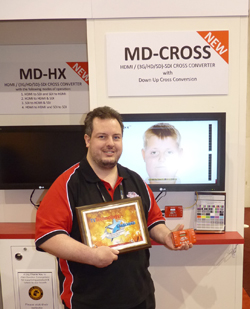
Redbyte’s Greg Wright accepts the STAR for Decimator Design MD CROSS, a low-cost portable converter that incorporates a new easy-to-use LCD and button control system to provide high-quality HDMI/SDI cross-conversion with scaling and frame-rate conversion.

J.T. Davis of Digital Broadcast, accepts the STAR for Spot Commander, which allows stations that accept ads from outside production companies to automate the process. Content is uploaded via a web-based GUI, and is automatically QC- checked for audio, video, and other parameters.
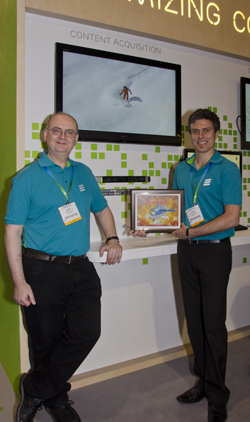
Ericsson’s Mark Horton (L) and Fabio Murra accept the STAR for the Ericsson AVP 3000 Voyager, for live content acquisition. It’s the only product to offer a hot-swappable modular architecture capable of supporting MPEG-2, MPEG-4 AVC and JPEG 2000 video compression over satellite and IP networks.
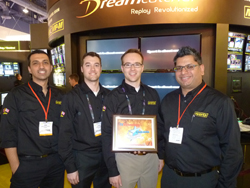
(L-R): Nima Malekmanesh, Chris Johnson, Darryl Wallace and Mo Goyal of Evertz accept the STAR for Dreamcatcher, the company’s first entry in the server-based content replay arena. Dreamcatcher’s editing technology enables users to experience reliable and precise slo-mo replays.
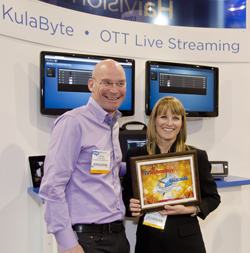
Peter Maag (L) and Joanne Gaudreau of Haivision accept the STAR for the Haivision KulaByte 4.0, a software-based live H.264 video transcoder that delivers the highest quality RTMP Dynamic Streaming for Flash video and Adaptive HTTP Live Streaming (HLS) for iOS devices.
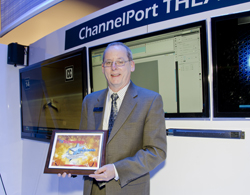
Mark Cousins of Harmonic accepts the STAR for the ChannelPort next-generation branded content playout system, which marks the company’s first entry into broadcast channel branding. It features multilayer graphics, dynamic text and a user GUI with preview of the graphics and branding.
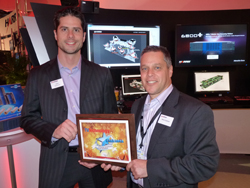
Harris’s Allan Delauner (L) and Steve Copeland accept the STAR for the Magellan network management system. Magellan NMS offers one consolidated user interface for the monitoring and control of multiple channels or facilities, and the flexibility to interface with Harris equipment and any third-party device.

JVC’s Koji Tsukada accepts the STAR for the GY HM600 camcorder. Targeting news, sports and independent production, the GY-HM600 features a built-in wide-angle 23x autofocus zoom lens, delivers superior low-light performance, and provides excellent sensitivity (F11 at 2000 lux) in a comfortable, versatile form factor.
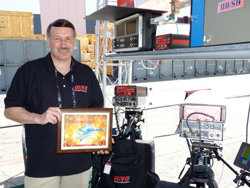
Warren J. Parece with Microwave Video Systems (MVS) accepts the STAR for the PortaQAM microwave modulator/demodulator. The MVS PortaQAM lets you feed a digital ASI signal into an old analog microwave transmitter and recover a flawless ASI signal at the receive end, and it costs many thousands less than replacing the transmitter and receiver.
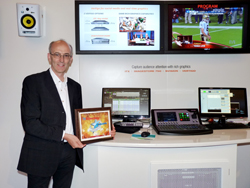
Ian Fletcher, Miranda’s CTO, accepts the STAR for Miranda’s iTX MC IT-based automated playout for multiformat content delivery. iTX Master Control brings together two products in one solution: the power and scalability of iTX playout, with the quality and ease of use of Imagestore master control.

Frank Jachetta of Multidyne accepts the STAR for the Silverback II camera-mounted fiber-based video transport system. Silverback II features a newly enhanced design with a simple and intuitive user interface. It transports all camera signals including SDI video, audio, control data, GPIOs, and tally and is ideally suited for sports and ENG.

Ofir Benovici (L) and Efi Dilmoni of Orad accept the STAR for Orad TD Control. Designed for news, sports, and other fast-turn around productions that leverage video box presentations to connect audiences with remote on air talent, TD Control consolidates the video streams into a single layout with complete control over video and graphics placement.
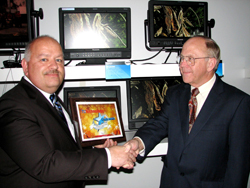
Panasonic’s Jim Wickizermarketing manager, (L) receives the STAR from TV Technology’s Technology Editor, James O’Neal, for the BT-LH1850 video monitor. With HD/SD SDI and HDMI connectivity, the LH1850 offers a 3D look-up table (LUT), which produces faithful color hues and smooth gradation, together with quick-response motion images.

Danny Wilson of Pixelmetrix, accepts the STAR for the OTT Media Grinder (OMG). Testing an on-demand OTT network for Quality of Service is difficult. Pixelmetrix solved this with OMG, which can test an OTT network with up to 2,000 simultaneous playback requests—which the company says is equivalent to hiring 2,000 college students.
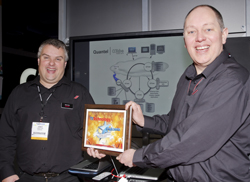
James Cain (L) and Richard Cartwright accept the STAR for Quantel revolutionQ, which allows users to access hundreds of terabytes of media… online, instantly and by any number of users. It uses OTS storage options and a proprietary broadcast production system to allow years of content to be stored online and be accessible instantly to simultaneous users.

Hank Frecon accepts the STAR for the RadiantGrid New Media Automation Platform, designed to enable a more efficient solution for file-based creation and distribution of media. It’s augmented and integrated with trafficking, rights management, linear automation, and business process management systems.
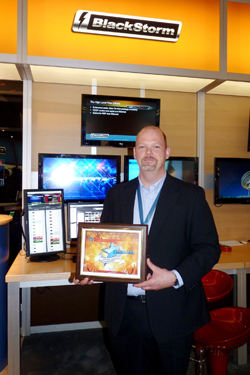
Todd Robinson with Ross Video accepts the STAR for the Ross Blackstorm Video Server, a two-channel HD 1RU video player that natively supports the Quicktime (.mov) file format and a selection of codecs. It provides an easy-to-use, user-configurable and intuitive client/server interface fully integrated into the Ross DashBoard Control System.
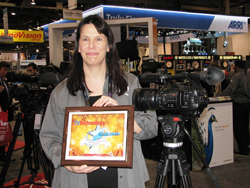
Barbara Jaumann, Sachtler’s product manager, accepts the STAR for the ACE tripod system. Targeting the growing video and DSLR filmmaker market, ACE features an ergonomic design, intuitive operation, and a payload range of 8.8 pounds (zero to 4 kg). ACE is ideal for lightweight HDV camcorders and video-enabled DSLR cameras.

Schneider Optics’ Dwight Lindsey accepts the STAR for the iPro lens system, designed for iPhone 4/4S. The Wide Angle and Fisheye Lenses use a bayonet mount to securely fasten onto the iPhone case. The iPhone case gives users the option of attaching the handle on the left or right side of the iPhone.

Jerry Lewis with Sierra Video, accepts the STAR for the Sierra Video Aspen 3232, a multirate router compatible with 3G, HD-SDI and SDI signals from 19 Mbps to 2.97 Gbps (3G). At only 2.5-inches deep, it occupies just 2RU in a standard equipment rack. The Aspen 3232 is also tremendously energy efficient.
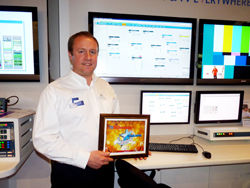
Snell’s Karl Mehring accepts the STAR for the Momentum media asset management system. Momentum employs thin-client service oriented architecture (SOA) to control a suite of proprietary and third-party applications running on various hardware platforms.
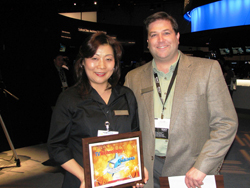
Sony’s Chiyoko Yannette and Tom Dinome accept the STAR for Sony’s NEX FS700 E-mount camcorder. The new Super 35mm model is designed for high-speed shooting, capable of capturing footage at up to 960 frames per second, all for a very reasonable price.
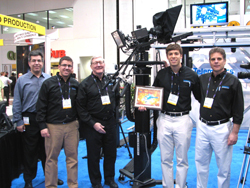
The Telemetrics staff accepts the STAR for the company’s new EP5 Televator robotic camera support column. The EP5 is capable of considerably greater height than previous units (65 inches) and can be used upside down for ceiling mounting, or for use with the company’s ceiling-mounted track system.
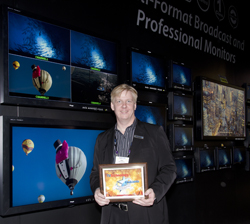
TVLogic’s Wes Donahue accepts the STAR for the LQM-471W monitor, a 47-inch 1920x1080 quad input monitor designed for multisource monitoring in control rooms. With four SDI inputs/outputs, the LQM-471W supports multiple display configurations with features like Waveform/Vector Scope, CC support, etc.
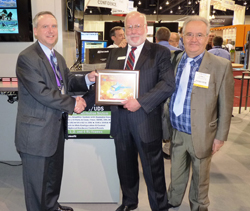
TV Technology’s Tom Butts (L) presents the STAR to Utah Scientific President Tom Harmon (C) and Chairman of the Board Carmelo Catalano, for the Utah-100/UDS Universal Distribution System, an affordable, compact 3 Gbps routing system. It’s a very practical router for small facilities, broadcast and post.
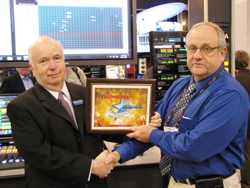
Gary Snow, Wheatstone’s founder and CEO, accepts the STAR Award from TV Technology’s Joey Gill for the Sideboard rackmounted compact audio control surface. The audio mixer control surface provides a lot of high-quality digital audio capability in a very small package.
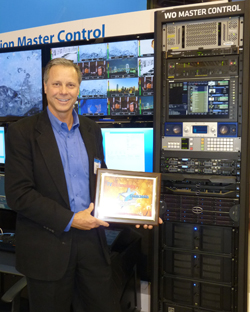
WideOrbit’s Alex A. Petterson accepts the STAR for the company’s complete station in a “rack,” a 16-channel HD turnkey system that includes traffic, automation, servers and all necessary components in a single rack, ready to plug in. The BXF-compliant system can be used for broadcast or multichannel playout.

Wohler President Carl Dempsey receives the STAR for the company’s ION remote monitoring platform. iON provides real-time streaming of audio, video, MPEG ASI, and metadata from locally installed, modular hardware platforms that manage all I/O connections at their source.

Dr. Philip Storey, XenData’s CEO, accepts the STAR for SX-10 network appliance an LTO archive in 1RU (plus up to two external LTO-drives) that makes archiving affordable with a simple interface in a 1RU chassis. It connects on a network and can be managed across any file-based workflow.
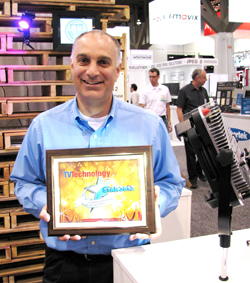
Zylight’s Charlie Collias accepts the STAR for the company’s folding Fresnel lighting fixture. The folding Fresnel light uses LEDs on the backplane, where dissipating heat is not a problem. The lens can move back and forth to provide focus, and the whole assembly can be folded to about three inches flat.
